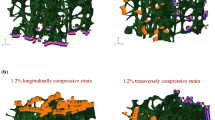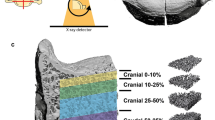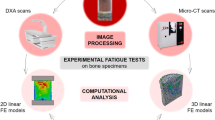Abstract
The aim of this study was to obtain the apparent and tissue-level mechanical parameters of vertebral cancellous bones using micro-finite element analysis, and to identify the regional variations and their relative differences with respect to aging. Ninety trabecular specimens were obtained from six normal L4 vertebral bodies of six male cadavers in two age groups, three aged 62 years and three aged 69 years, and then were scanned using a high-resolution micro-Computed Tomography (micro-CT) system. The obtained micro-CT reconstruction models were then converted to micro-finite element models. Micro-finite element analyses were done to determine the apparent Young’s moduli and tissue-level Von Mises stress distribution for each trabecular specimen on the longitudinal direction, and medial–lateral and anterior–posterior directions (transverse directions), respectively. Regional variations about the mechanical parameters at both apparent and tissue levels in different transverse layers and vertical columns within and between the two age groups were then analyzed. The results showed significant decreases in the apparent Young’s moduli in each direction with aging, and those in the two transverse directions decreased more with aging compared with the longitudinal direction. Furthermore, there were no statistically significant differences between the mechanical parameters in the two transverse directions in both age groups. This study offered an insight into the distributions and variations of mechanical properties within a vertebral body. The mechanical parameters calculated from this study may help in a better understanding of regional fracture risks and the vertebral fracture mechanism in the prevention of osteoporotic fracture in elder individuals.



Similar content being viewed by others
References
Adams M. A., Mcnally D. S., Dolan P. (1996) ‘Stress’ distributions inside intervertebral discs—the effects of age and degeneration. J. Bone Joint Surg. 78-B:965–972
Borah B., Dufresne T. E., Chmielewski P. A., Gross G. J., Prenger M. C., Phipps R. J. (2002) Risedronate preserves trabecular architecture and increases bone strength in vertebra of ovariectomized minipigs as measured by three-dimensional microcomputed tomography. J. Bone Miner. Res. 17:1139–1147
Chung H., Wehrli F. W., Williams J. L., Kugelmass S. D. (1993) Relationship between NMR transverse relaxation, trabecular bone architecture, and strength. Proc. Natl. Acad. Sci. U.S.A. 90:10250–10254
Ding M., Hvid I. (2000) Quantification of age-related changes in the structure model type and trabecular thickness of human tibial cancellous bone. Bone 26:291–295
Ding M., Odgaard A., Linde F., Hvid I. (2002) Age-related variations in the microstructure of human tibial cancellous bone. J. Orthop. Res. 20:615–621
Ferguson S. J., Steffen T. (2003) Biomechanics of the aging spine. Eur. Spine J. 12:S97–S103
Gong H., Zhang M., Yeung H. Y., Qin L. (2005) Regional variations in microstructural properties of vertebral trabeculae with ageing. J. Bone Miner. Metab. 23(2):174–180
Gong H., Zhang M., Qin L., Lee K. K. H., Guo X., Shi S. Q. (2006) Regional variations in microstructural properties of vertebral trabeculae with structural groups. Spine 31(1):24–32
Hansson T., Roos B. (1981) The relationship between bone mineral content, experimental compression fractures, and disc degeneration in lumbar vertebrae. Spine 6:147–153
Hansson T., Keller T. S., Panjabi M. M. (1987) A study of the compressive properties of lumbar vertebral trabeculae: effects of tissue characteristics. Spine 12:56–62
Homminga J., McCreadie B. R., Ciarelli T. E., Weinans H., Goldstein S. A., Huiskes R. (2002) Cancellous bone mechanical properties from normals and patients with hip fractures differ on the structural level, not on the bone hard tissue level. Bone 30(5):759–764
Homminga J., Van Rietbergen B., Lochműller E. M., Weinans H., Eckstein F., Huiskes R. (2004) The osteoporotic vertebral structure is well adapted to the loads of daily life, but not to infrequent “error” loads. Bone 34:510–516
Homminga J., Weinans H., Gowin W., Felsenberg D., Huiskes R. (2001) Osteoporosis changes the amount of vertebral trabecular bone at risk of fracture but not the vertebral load distribution. Spine 26(14):1555–1561
Judex S., Boyd S., Qin Y. X., Turner S., Ye K., Muller R., Rubin C. (2003) Adaptations of trabecular bone to low magnitude vibrations result in more uniform stress and strain under load. Ann. Biomed. Eng. 31:12–20
Kabel J., Van Rietbergen B., Odgaard A., Huiskes R. (1999) Constitutive relationships of fabric, density, and elastic properties in cancellous bone architecture. Bone 25:1159–1164
Keaveny T. M., Wachtel E. F., Ford C. M., Hayes W. C. (1994) Differences between the tensile and compressive strengths of bovine tibial trabecular bone depend on modulus. J. Biomech. 27:1137–1146
Keller T. S., Hansson T. H., Abram A. C., Spengler D. M., Panjabi M. M. (1989) Regional variations in the compressive properties of lumbar vertebral trabeculae—effects of disc degeneration. Spine 14:1012–1019
Lau E. M. C., Woo J., Leung P. C. (1993) Low bone mineral density, grip strength and skinfold thickness are important risk factors for hip fracture in Hong Kong Chinese. Osteoporos. Int. 3:66–69
Melton L. J., Chrischilles E. A., Cooper C., Lane A. W., Riggs B. L. (1992) Perspective: how many women have osteoporosis?. J Bone Miner. Res. 7:1005–1010
Morgan E. F., Bayraktar H. H., Keaveny T. M. (2003) Trabecular bone modulus-density relationships depend on anatomic site. J. Biomech. 36:897–904
Mosekilde L. (1988) Age-related changes in vertebral trabecular bone architecture—assessed by a new method. Bone 9:247–250
Pollintine P., Dolan P., Tobias J. H., Adams M. A. (2004) Intervertebral disc degeneration can lead to “stress-shielding” of the anterior vertebral body. Spine 29:774–782
Qin L., Au S. K., Leung P. C., Lau M. C., Woo J., Choy W. Y., Hung W. Y., Dambacher M. A., Leung K. S. (2002) Baseline BMD and bone loss at distal radius measured by pQCT in peri- and postmenopausal Hong Kong Chinese women. Osteoporos. Int. 13(12):962–970
Rho J. Y., Ashman R. B., Turner C. H. (1993) Young’s modulus of trabecular and cortical bone material: ultrasonic and microtensile measurements. J. Biomech. 26:111–119
Rho J. Y., Tsui T. Y., Pharr G. M. (1997) Elastic properties of human cortical and trabecular lamellar bone measured by nanoindentation. Biomaterials 18:1325–1330
Simpson E. K., Parkinson I. H., Manthey B., Fazzalari N. L. (2001) Intervertebral disc disorganization is related to trabecular bone architecture in the lumbar spine. J. Bone Miner. Res. 16:681–687
Van Rietbergen B., Odgaard A., Kabel J., Huiskes R. (1998) Relationships between bone morphology and bone elastic properties can accurately quantified using high-resolution computer reconstructions. J. Orthop. Res. 16:23–28
Van Rietbergen B., Weinans H., Huiskes R., Odgaard A. (1995) A new method to determine trabecular bone elastic properties and loading using micromechanical finite-element models. J. Biomech. 28:69–81
Van Rietbergen B., Kabel J., Odgaard A., Huiskes R. (1997) Determination of trabecular bone tissue elastic properties by comparison of experimental and finite element results. In: Sol H., Oomens C. W. J. (eds) Material Identification Using Mixed Numerical Experimental Methods. Kluwer Academic, Devente, The Netherlands, pp. 183–192
Acknowledgments
This work is supported by The Hong Kong Polytechnic University Central Research Grant A/C No. G-YX64 and National Natural Science Foundation of China under Grant No. 10502021.
Author information
Authors and Affiliations
Corresponding author
Rights and permissions
About this article
Cite this article
Gong, H., Zhang, M., Qin, L. et al. Regional Variations in the Apparent and Tissue-Level Mechanical Parameters of Vertebral Trabecular Bone with Aging Using Micro-Finite Element Analysis. Ann Biomed Eng 35, 1622–1631 (2007). https://doi.org/10.1007/s10439-007-9332-8
Received:
Accepted:
Published:
Issue Date:
DOI: https://doi.org/10.1007/s10439-007-9332-8




